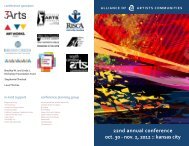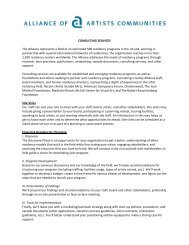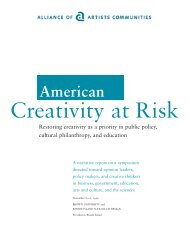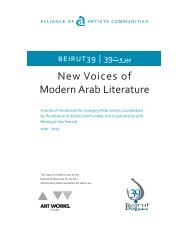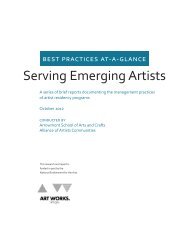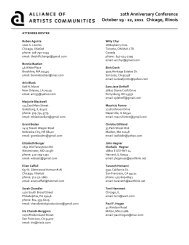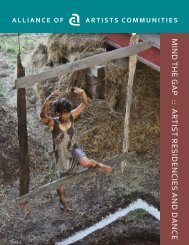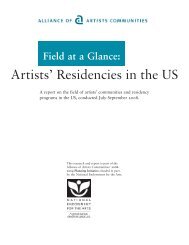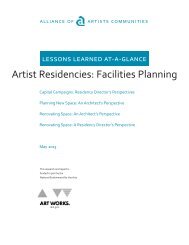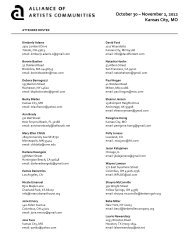Artist-in-Residence Selection - Alliance of Artists Communities
Artist-in-Residence Selection - Alliance of Artists Communities
Artist-in-Residence Selection - Alliance of Artists Communities
Create successful ePaper yourself
Turn your PDF publications into a flip-book with our unique Google optimized e-Paper software.
<strong>Artist</strong>-<strong>in</strong>-<strong>Residence</strong> <strong>Selection</strong><br />
Introduction<br />
From Omaha, Nebraska to H<strong>of</strong>dastrond, Iceland and New<br />
York City to Greensboro, North Carol<strong>in</strong>a, there are over 1,000<br />
residency programs worldwide that support today’s artists by<br />
<strong>of</strong>fer<strong>in</strong>g time and space for the creation <strong>of</strong> new work. Each<br />
program differs based on location, organizational culture, and<br />
mission, and these factors determ<strong>in</strong>e which types <strong>of</strong> artists a<br />
program aims to attract and the processes used to select them.<br />
What’s unique about your program and/or your community that<br />
makes it better suited to particular artists? There is no right way<br />
to manage selection – decide first who you want to serve and<br />
then design a process that will get you there.<br />
Def<strong>in</strong>e your selection process<br />
The follow<strong>in</strong>g are examples <strong>of</strong> selection processes commonly<br />
used by residency programs, <strong>in</strong>dividually or <strong>in</strong> comb<strong>in</strong>ation with<br />
each other. Roughly 64% <strong>of</strong> residency programs have an open<br />
application process, 14% have a closed process (nom<strong>in</strong>ated,<br />
curated, or awarded residencies), and 22% select artists through<br />
both open and closed processes.<br />
• “Bl<strong>in</strong>d” selection – <strong>Selection</strong> is based on work samples,<br />
without consideration or awareness <strong>of</strong> personal <strong>in</strong>formation<br />
(age, gender, race, etc.).<br />
• “Non-bl<strong>in</strong>d” selection – Jurors take <strong>in</strong>to consideration other<br />
factors <strong>in</strong> addition to the quality <strong>of</strong> work, e.g., project<br />
proposals and statements <strong>of</strong> <strong>in</strong>tent, demographic <strong>in</strong>formation,<br />
and/or education/exhibition/residency experiences.<br />
• Nom<strong>in</strong>ate-to-apply – <strong>Artist</strong>s are <strong>in</strong>vited to apply, but are not<br />
guaranteed a residency.<br />
• Curated residencies – The selection committee chooses artists<br />
that they want to be <strong>in</strong> residence and then <strong>in</strong>vites them. This<br />
process can completely remove the application process<br />
• Awarded or endowed residencies – <strong>Artist</strong>s are selected by a<br />
partner organization (a university or arts council, for example)<br />
or as part <strong>of</strong> an award; the residency organization may or may<br />
not be <strong>in</strong>volved <strong>in</strong> the selection.<br />
Start with the application<br />
Know what you are look<strong>in</strong>g for and design your application<br />
accord<strong>in</strong>gly. For example, a retreat center for established<br />
artists may need different <strong>in</strong>formation from applicants than a<br />
community-based residency for emerg<strong>in</strong>g artists. It’s important<br />
to keep your selection process <strong>in</strong> m<strong>in</strong>d when design<strong>in</strong>g your<br />
application, too, so that you capture <strong>in</strong>formation that will allow<br />
you to make <strong>in</strong>formed decisions. Consider the follow<strong>in</strong>g when<br />
creat<strong>in</strong>g your application:<br />
• How does the language you use convey <strong>in</strong>clusivity/exclusivity?<br />
• What does your jury and/or staff need to make the best<br />
decisions and how will they view that <strong>in</strong>formation?<br />
• What <strong>in</strong>formation do you want to track over time about your<br />
applicants (e.g., ethnicity/race, age, career stage, education<br />
level)?<br />
Choose a jury as carefully as you choose<br />
your residents<br />
The artists who participate <strong>in</strong> your program will become part<br />
<strong>of</strong> and contribute to your organization and its culture. It’s<br />
essential that the people who are a part <strong>of</strong> your jury “get it”<br />
– that they understand your organization’s values and are<br />
not just experts <strong>in</strong> the field. Choose jurors that reflect your<br />
program’s mission and goals. Juries can be comprised <strong>of</strong> staff,<br />
board members, alumni, other artists, curators, arts leaders, and<br />
laypersons; and local, national, or <strong>in</strong>ternational representatives.<br />
A jury can be used exclusively to determ<strong>in</strong>e acceptance or as one<br />
or more phases <strong>of</strong> the selection process.<br />
While you don’t have to f<strong>in</strong>d all new jurors annually, it’s a good<br />
idea to rotate jurors regularly so that artist selection does not<br />
stagnate. F<strong>in</strong>d<strong>in</strong>g new jurors each year can be challeng<strong>in</strong>g,<br />
especially if you are <strong>in</strong> a small community, though onl<strong>in</strong>e<br />
application programs can allow for virtual jury<strong>in</strong>g anywhere <strong>in</strong><br />
the world. Other residency programs, colleges and universities,<br />
arts councils and funders, and other arts organizations can all be<br />
a source for identify<strong>in</strong>g jurors. Grant-makers will likely already<br />
have a roster <strong>of</strong> jurors they can recommend.<br />
Inform potential jurors when you <strong>in</strong>vite them <strong>of</strong> your<br />
expectations (how many applications they will review, whether<br />
they will be responsible for review<strong>in</strong>g all the applications or<br />
just a portion <strong>of</strong> them, how much time they will have to review<br />
applications <strong>in</strong> advance, and what your goals are). Def<strong>in</strong>e your<br />
entire selection process accord<strong>in</strong>g to your needs, and go over it<br />
before the jurors receive materials.<br />
<strong>Alliance</strong> <strong>of</strong> <strong>Artist</strong>s <strong>Communities</strong>




